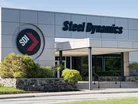Steel Dynamics Sets Ambitious Targets to Reduce Scope 3

Steel Dynamics, Inc. has taken a significant step in addressing Scope 3 emissions through its recently announced greenhouse gas (GHG) emissions reduction targets for its steel mills.
The targets, certified by the Global Steel Climate Council (GSCC), demonstrate the company's commitment to decarbonisation across its operations and supply chain.
Science-based standards for emissions reduction
The GSCC's Steel Climate Standard, which guides Steel Dynamics' emissions reductions, is particularly noteworthy for including Scope 3 emissions.
The announcement states that the standard "measures key steelmaking GHG emissions through hot rolling including Scope 1, Scope 2 and upstream Scope 3 emissions categories."
The comprehensive approach ensures that Steel Dynamics addresses emissions not just from its direct operations but from its supply chain.
Low-carbon steel production
Mark D. Millett, Chairman and CEO of Steel Dynamics, emphasised the company's proactive stance on emissions reduction, stating: "Steel Dynamics is already a leader in producing lower-carbon steel products. In 2023, we achieved our previously announced 2025 GHG emissions intensity and renewable energy goals ahead of schedule. Even though our emissions are already among the lowest in the industry, we are committed to further reducing our carbon impact and have an actionable path forward."
Investment in biocarbon technology
A key initiative in Steel Dynamics' strategy to reduce Scope 3 emissions is its US$260m investment in a biocarbon production facility. The facility will begin operations in early 2025 and will replace anthracite with biocarbon in the steelmaking process. While primarily targeting Scope 1 emissions, this shift to a more sustainable carbon source will likely have ripple effects throughout the supply chain, potentially reducing Scope 3 emissions from raw material extraction and transportation.
Renewable energy commitments
Its significant renewable energy purchase agreement, covering approximately 15% of its steel mills' electricity consumption, has implications for Scope 3 emissions.
By reducing the carbon intensity of its energy supply, Steel Dynamics indirectly lowers the emissions associated with its products throughout its lifecycle.
Lower-carbon steel
Steel Dynamics' commitment to ongoing research and development of innovative technologies for sustainable steel production could lead to further reductions in Scope 3 emissions.
As these technologies are implemented and scaled, they influence practices across the industry, potentially leading to broader reductions in supply chain emissions.
Mark highlights the importance of lower-carbon steel in the global economy: "Steel is an integral component of the global economy and foundational to the world's essential infrastructure. Specifically, lower-carbon steel is necessary to transition to a lower-carbon global economy. With the new targets and a proven track record of progress, we are demonstrating our commitment to continue making the Steel required for a sustainable future."
By setting these ambitious targets and implementing strategies that address emissions across all scopes, Steel Dynamics is positioning itself as a leader in sustainable steel production.
The approach reduces the company's carbon footprint and contributes to lowering the Scope 3 emissions of its customers and partners throughout the value chain.
Receive the next edition of Scope 3 Magazine by signing up for our newsletter.
As part of this portfolio, make sure you check out Procurement Magazine and also sign up to our global conference series – Procurement & Supply Chain LIVE.
Also check out our sister brand, Sustainability Magazine and sign up to its global conference series – Sustainability LIVE.
Scope 3 Magazine is a BizClik brand.
- Maersk Sustainability Reporting: Navigating Scope 3Transportation & Logistics
- SHEIN’s Scope 3 Emissions: Fast Fashion’s Carbon BurdenCircular Economy
- Tackling Super Bowl LIX's Scope 3 Emissions ChallengeScope 1 2 and 3
- NetApp’s SBTi Validation Marks Sustainability MilestoneScope 1 2 and 3
Featured Articles
Estonia, Latvia and Lithuania join the European grid, cutting ties with Russian energy, a move that boosts regional security and sustainability
TÜV SÜD: New battery regulations bring Scope 3 hurdles, requiring sustainable sourcing, digital traceability and design changes increasing compliance
Nissan is scaling up its use of green steel, reducing CO2 emissions in its supply chain as part of its goal to achieve carbon neutrality by 2050

